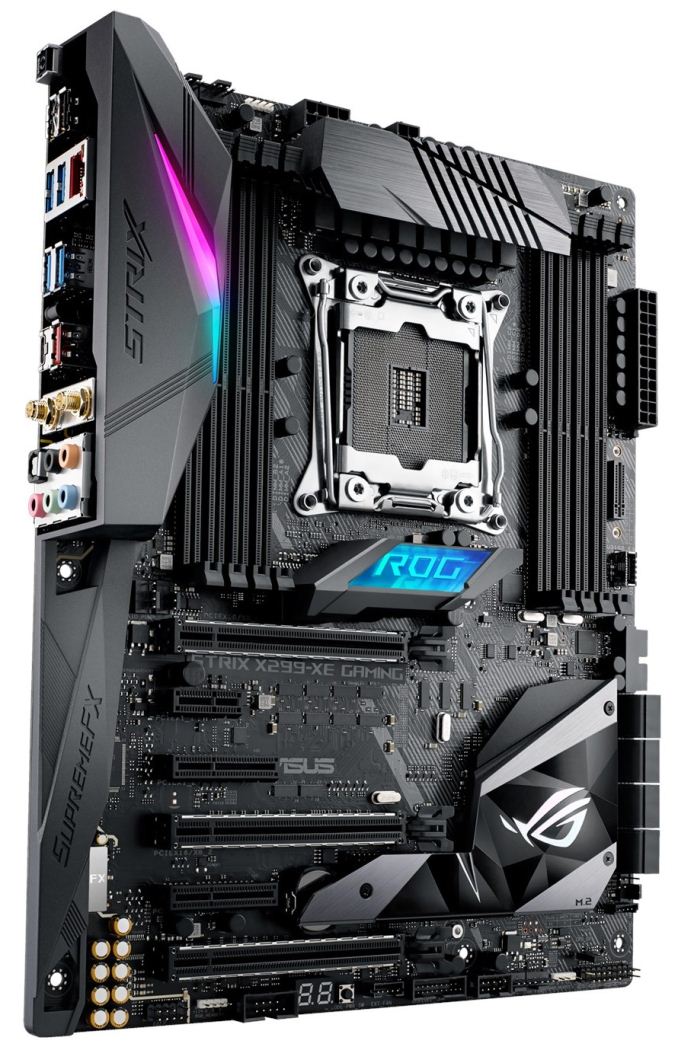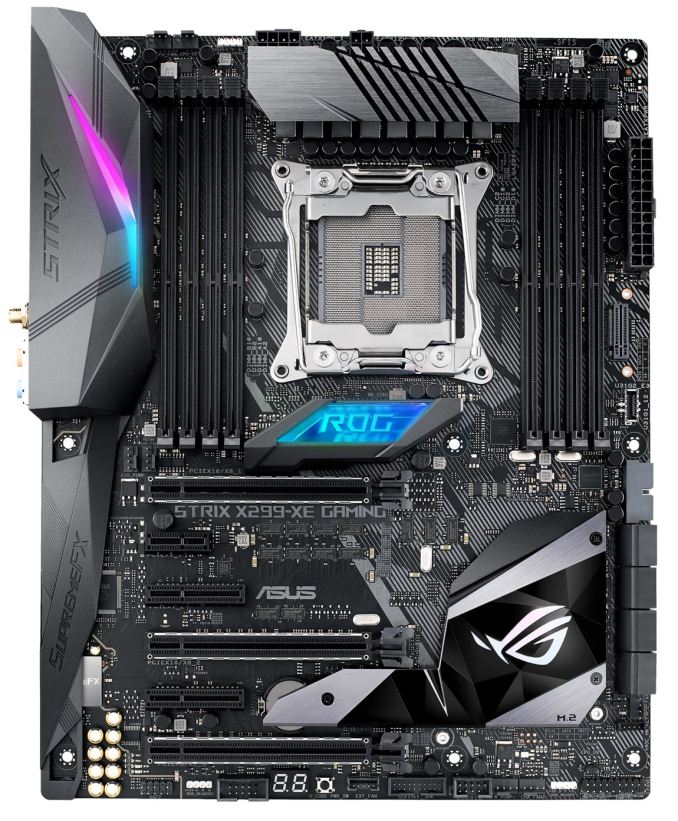The ASUS ROG Strix X299-XE Gaming Motherboard Review: Strix Refined
by Joe Shields on December 11, 2017 8:00 AM EST- Posted in
- Motherboards
- Asus
- X299
- Skylake-X
- Kaby Lake-X
Conclusion
Given the price of the ASUS ROG Strix X299-XE Gaming, it seems to be targeted as a 'mid-range+' board for an enthusiast level gamer. The enthusiast gamer tends to take things a more serious than a casual gamer and can spend a bit more on high-end parts. These users will pass the blurred lines of HEDT platform and the mainstream, often skipping the Kaby Lake processors built for the X299 platform. Instead of paying $350 or less for a 7740K or 7640X, they go straight in for a higher core count CPU such as the six-core i7-7800X ($389) or an eight-core i7-7820X ($599). With this, there are more PCIe lanes to use and it opens up the platform for multi-GPU capabilities and more freedom for M.2 based devices. The XE version of this board over the non-XE version simply adds a larger and slightly different styled heatsink as well as including a 40mm fan and a mounting bracket to the updated heatsink. No other changes between the two were made.
The ROG Strix X299-XE Gaming has most of the bells and whistles that we expect as default on the X299 platform. USB 3.1 (10 Gbps) duties are handled by the ASMedia 3142 controller which uses a bit less power and offers better performance than the 2142 controller seen in Z270 boards. It has a single wired LAN controller in the I219-V, a proven performer, to which ASUS also offers ESD protection and traffic management for prioritizing streams to optimize performance in online games. Control over the 8-phase VRM is handled by a well regarded IR (now Infineon) IR35201 8-channel controller ensuring accurate voltage is delivered to the processor.
The build quality on the ROG Strix was quite good. The larger heatsink has lines cut into it allowing more heat to escape and air to get in there when the fan is on top. Both the VRM front and back was mounted well and made contact with everything it was supposed to which kept it running within specifications during our testing. The oversize chipset and M.2 heatsink also worked well. RGB LEDs were integrated tastefully on the board with only the ROG feature and the back panel IO shroud having RGB LEDs. The ROG RGB LED feature is customizable using a 3D printer with ASUS giving instructions/templates on the website.
Performance on the ASUS out of the box is where things fell a bit short. Though it did well in our main system tests such as power and DPC Latency, it was middle of the pack on tightly coupled tests, or lower in a couple of tests due to how the board handles frequency at stock. In our testing, the i7-7900X boosted to 3.6 GHz on all cores - it appears it simply uses the Intel defaults while other boards we have looked at so far, enable some minor overclocking features by default. This results in the other boards giving an increase in scores over the default Intel boost tables. All this goes out the window when overclocking, to which the Strix X299-XE Gaming was a nice performer matching the 4.5 GHz our CPU can do. The auto-overclocking tools were a little aggressive, giving stability issues.
The ASUS ROG Strix X299-XE Gaming is going to have most, if not all the features an enthusiast level gamer needs to get up and fragging. It uses a high-end audio codec, the latest connectivity with USB 3.1 (10 Gbps) Type-A and Type-C ports, some muti-GPU support, and multiple M.2 ports. The XE name means that it adds to the beefy VRM cooler and provides a fan to support 165W CPUs and higher overclocks better.
However, the difference is in the fine details. At $50 more than the standard Strix, and $370 overall, it doesn't strike the $350-$400 price bracket with fear. In fact, for $323 dollars (around the cost of the non-XE ASUS ROG Strix), the ASRock X299 Taichi XE has the beefed-up heatsink, Wi-Fi, three M.2 slots, high-end audio codec, etc and costs almost $50 less, albeit with fewer gaming oriented software features. For the Strix XE, at $370, it is missing a key factor to make it an obvious sale.
Other AnandTech Reviews for Intel’s Basin Falls CPUs and X299
- The Intel Skylake-X Review: Core i9-7980XE and Core i9-7960X Tested
- The Intel Skylake-X Review: Core i9-7900X, i7-7820X and i7-7800X Tested
- The Intel Kaby Lake-X Review: Core i7-7740X and i5-7640X Tested
- Intel Announces Basin Falls: The New High-End Desktop Platform and X299 Chipset
- ($400) The ASRock X299E-ITX/ac Review [link]
- ($390) The ASRock X299 Professional Gaming i9 Review: [link]
- ($370) The ASUS Strix X299-XE Gaming Review (this review)
- ($350) The MSI X299 Gaming Pro Carbon Review [link]
- ($340) The ASUS X299 TUF Mark 1 Review [link]
- ($290) The ASRock X299 Taichi Review [link]
- ($280) The MSI X299 Tomahawk Arctic Review [link]
- ($260) The MSI X299 SLI Plus Review [link]












27 Comments
View All Comments
PeachNCream - Monday, December 11, 2017 - link
Yup, but saying "never" speaks in absolute terms and that's not accurate.HStewart - Monday, December 11, 2017 - link
Multi-CPU systems have always been the market for severs and high end workstations. I purchase my Dual Xeon 5160 Supermicro for Lightwave 3d creations. These type system have application that used multiple threads and especially on servers.When I research for Dual Xeon systems, the advantage of multi-cpu Xeon ( not sure if applies to AMD ) was increase IO abilities. Plus at time 5160 was only dual-core - so it gave me 4 cores.
Today's system with so much interest in increase core count especial on non-server enviroments is kind of strange - i guess instead of throwing faster performance - they throw cores in to it. But the AMD vs Intel core wars reminds me of old frequencies wars - it just silly to just to say you have more cores in non server enviroment where most of user interface and logic is single threaded. Yes in time multiple threads will come about - but it more difficult for software developers to do that user interface.
Of course we can say never on this - because with multitasking, the more threads / cores the better it is. Especially in development enviroments with VM and compilers that can used multiple threads
SanX - Wednesday, December 13, 2017 - link
"Inflate the cost", "complex socket" and "more expensive motherboards" sounds like words from Intel press releases. The tech is known for decades, costs nothing to implement, is working on xeons and everyone else including all graphics processors no matter what price.Times changed. Adding more cores already reaching it's thermal design limit, 200-300W and the game is over, so the performance scaling with core counts on the die becomes deeply sublinear for the most tasks, for example linear algebra. The only way which is practically left is increase of sockets on the board.
HStewart - Monday, December 11, 2017 - link
I used to have a Pentium Pro motherboard - but with single CPU - it was a whopping $3500 back then.Now there is a big difference between Xeon and non-Zeon system besides the running CPU - Xeon have much greater IO performance than non Xeon CPU. I also have a dual 5160 3Ghz Zeon system and until some of later i7's - kept up with performance. It over ten years old and stills runs today - but I rarely run it now - just too much trouble ever since I got into laptops
HStewart - Monday, December 11, 2017 - link
Just for clarification, the Pentium Pro motherboard supported dual cpus - just I never purchase extra CPU.sonny73n - Monday, December 11, 2017 - link
They just don't like the idea of us upgrading our system with only another same old CPU, instead of upgrading the whole system.HStewart - Monday, December 11, 2017 - link
I have always upgraded both the CPU and MotherboardThe only exception if I could find newer Xeon cores for my Supermicro - especially if cost has gone down - but I do except trouble. When I building machines, it did not matter much - my older workstation system became a render node.
svan1971 - Thursday, December 14, 2017 - link
dude they make 22 core and 32 core cpus aparently less is moreSanX - Monday, December 11, 2017 - link
All mobos differing by the factor of mere 10% higher then others by some miniscule feature are inflated in price by the factor of 10. How much it costs to manufacturers to build these mobos in China? 20-25 bucks. If you doubt that wait for the next financial crisis to see their real price.Ro_Ja - Monday, December 11, 2017 - link
My old ass P35 motherboard has more USB ports compares to this one.I'm not saying that should but it's prolly cause for the PCI-e lanes,?